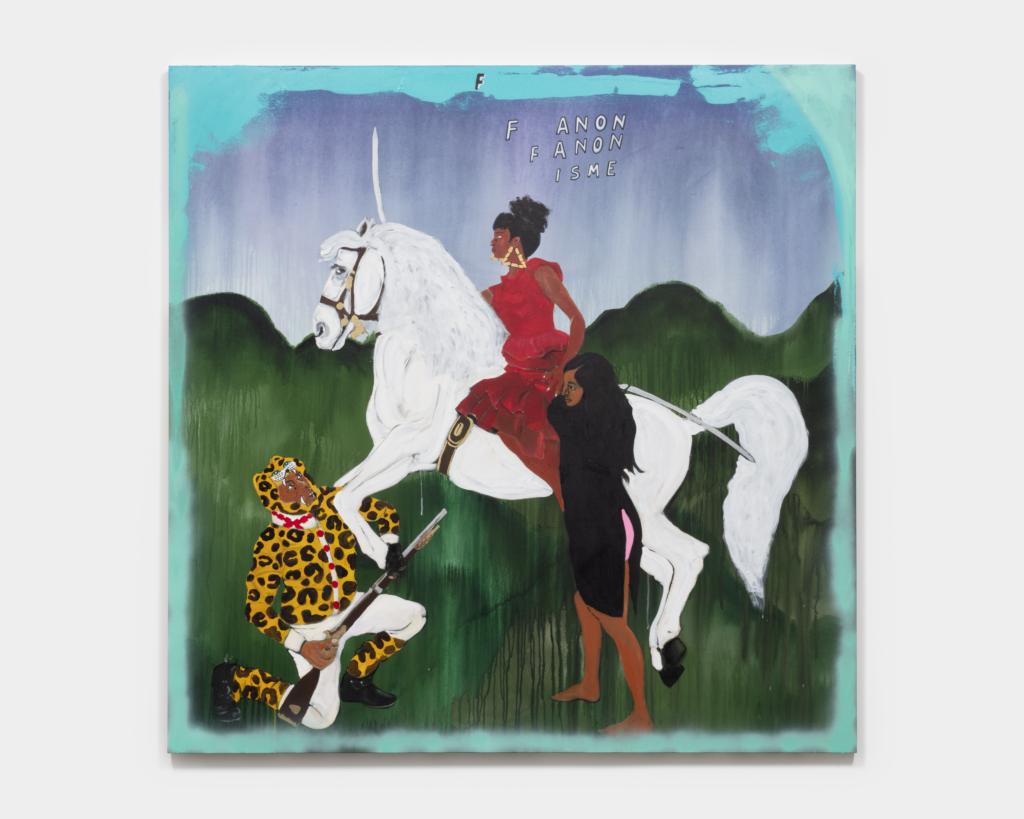The Review’s Review: En Garde

Umar Rashid, F Anon Is Me (Fanonisme as an answer to the scourge of colonialism) However, sometimes it is difficult to get to the ringleaders atop the pyramid and one must be satisfied by dispatching proxies. Ultimately, a wasted effort. Or, red woman on a horse, 2021. Acrylic and spray paint on canvas. 72 x 72 x 1 1/2 inches. Photo: Josh Schaedel
For the past few months, I’ve been avoiding museums. Even the smallest among them overwhelms me, a side effect, I assume, of the simultaneous overstimulation and sensory deprivation of life (my life) during the pandemic. It’s not their fault, really, and galleries are hardly the solution, but when I visited En Garde / On God, Umar Rashid’s first solo show at Blum & Poe in Los Angeles earlier this week, I felt the exhibition to be a kind of relief. In a series of large-scale paintings (and one sculpture), Rashid meticulously documents artifacts belonging to the fictitious Frenglish Empire (1658–1880), a portmanteau ushered in by the consolidation of French and English colonial powers. Together, the works read as something of an oblique but determining taxonomy, like the consequential false memories of a bad dream. Missionaries take the form of conversion therapists, white Jesus and black Jesus share the same lowrider, and everyone seems as if they might be on the verge of losing their heads. The show is up until December 18, and images of Rashid’s older works, belonging to the same narrative, are archived online. —Maya Binyam
I’m feeling like it’s been a while since this column has done something meta, so I’m recommending the UK magazine The Happy Reader as an excellent source for recommendations, both in their print issue’s Snippets column and their newsletter. From Denton Welch’s 1945 novel In Youth Is Pleasure to Stoicon (a convention for Stoics held annually in Toronto) to maxims overheard in Paris, reading their breezy appreciations is like skimming through a feed curated by your coolest friend’s algorithm. —Lauren Kane
The guitarist and living jazz legend Pat Metheny is a sort of guilty pleasure of mine, like listening to Rush—both are sometimes a bit too cheesy for their, and my, own good. But when the mood’s right, nothing else will work. I’ve been swooning a bit over Metheny’s latest, Side-Eye NYC (V1.IV), a live trio recording featuring the keyboardist James Francies (who seems to have twenty hands and at least as many keyboards at his disposal) and the drummer Marcus Gilmore, one of my favorites. They tackle old and new Metheny songs, with synths and effect-heavy guitar washing over Gilmore’s crumbly rhythms. Nothing here will surprise Metheny fans, but that’s part of what makes this disc so delicious. —Craig Morgan Teicher
I recently visited the Met’s phenomenal Surrealism Beyond Borders exhibition, an in-depth look at the global impact of surrealism in the twentieth century. Works by the usual suspects—a painting by Leonora Carrington, a sculpture by Dali—are included, but so too are wide-ranging examples from artists active in South Korea, Iran, Greece, and more. My particular favorites include the U.S. poet and artist Ted Joans’s “outographs,” a series of ghostly-looking photos with the subjects’ faces cut out; photographs of members of the Cairo surrealist collective al-Fann wa-I-Hurriya (Art et Liberté) by the Egyptian artist Georges Henein; manifestos from the Montreal-based Les Automatistes; and the 1954 Colombian film The Blue Lobster, featuring contributions from a young Gabriel García Márquez. With a firm emphasis on the politically revolutionary potential of surrealism and its various outgrowths, it’s a thought-provoking, creatively invigorating way to spend an afternoon. —Rhian Sasseen
Copyright
© The Paris Review
